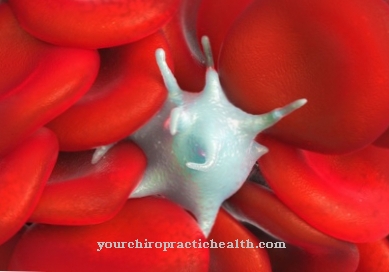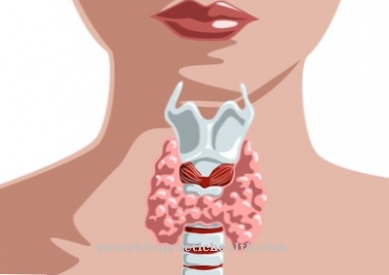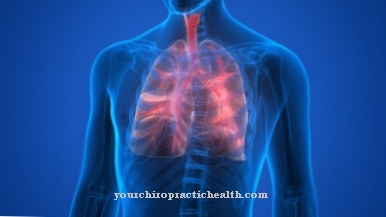As Clauss sign the neurologist describes a pyramidal sign that is closely related to the Strümpell sign. The Clauss sign is the movement of the toes and occurs when the knee is bent against resistance. The sign can indicate motor neuronal damage.
What is the Clauss sign?

The Clauss sign is known as the pyramid railway sign. The movement is most closely related to the Strümpell sign. The Clauss sign is checked together with the reflexes of the Babinski group during the neurological diagnosis. In the adult, a positive finding has pathological value.
Unlike the reflex movements of the Babinski group, the Clauss sign is actually not a reflex movement. Rather, it is a pathological movement of the limbs that occurs when the knee is flexed against resistance.
The Strümpell and Clauss signs are related to the reflexes of the Babinski group in that they are characterized by the same involuntary movements of the foot phalanx. In the Strümpell sign, bending the knee against resistance results in dorsiflexion of the big toe, which is accompanied by supination of the foot and spreading of the remaining toes. In addition to the dorsiflexion of the big toe, there is no supination of the foot with the Clauss sign. In addition to spreading the remaining toes, there is a plantar flexion of toes II to V in the direction of the sole of the foot. The Clauss sign can indicate damage to the central motor neurons.
Function & task
The differentiated movement of individual muscle groups is learned to a certain extent. Small children under one year of age cannot yet move individually adjacent muscle groups. Only after the first year of life does the superordinate motor control become evident through switching points such as the central motor neurons.
The central motor neurons are neurons of the central nervous system. They are connected to one another by the pyramidal tracts and control all motor functions of the human organism. The upper motor neuron is in the brain. The lower motor neuron is located in the anterior horn of the spinal cord. The pyramidal tracts connect the two motor neurons in descending order.
In the pyramidal system of mammals, the nerve cell processes of central motor neurons converge. The origin of the system lies in the primary motor cortex. In addition to the voluntary motor skills, the reflex motor skills are also controlled from here. Both gross motor and fine motor movements are interconnected via the pyramidal system.
Since the central control of all movements via the pyramidal system is not yet fully developed in children under one year of age, they move muscle groups together and also have various reflexes that are no longer available in adults thanks to the higher-level control. For this reason, toddlers also move the extensor of the big toe when the knee is bent against resistance.
Accordingly, toddlers can only move the individual muscles of the lower leg muscles together. The knee flexion by a lower leg muscle activates the remaining lower leg muscles, one of which extends into the big toe. The movement of the big toe muscle in turn activates the movement of the rest of the toes.
If this phenomenon can be observed in adults, then the failure of the superordinate control by the central motor neurons is a corresponding assumption, which is examined more closely by further tests. All the reflexes of the Babinski group are foot limb reflexes and pyramidal orbit signs. They are therefore usually examined together. However, they differ in their expressiveness. Since the Clauss sign and the Strümpell sign are very closely related, if the test is positive, usually only one of the two is given as a finding.
Illnesses & ailments
The pyramid orbital signs in the form of the Babinski group are not a 100% reliable diagnostic tool. However, they can at least give the neurologist initial indications of the localization of neurological damage. If only the big toe moves with one of the Babinski reflexes or the Clauss sign, then the test is not rated as a positive result. In this case, the finding is reported as questionable or paradoxical.
The Clauss sign alone does not allow any direct conclusion about motor neuronal damage. Like the Strümpell sign, the Clauss sign may also be present in healthy adults. However, if several of the Babinski group's reflexes also test positive, then neurological damage is likely. However, the general clinical picture of the patient must match a suspected diagnosis of motor neuronal damage.
Muscle weakness, spasticity or flaccid and spastic paralysis characterize the picture of motor neuronal lesions. General clumsiness can also fit into the clinical picture.
The cause of motor neuronal damage depends on the location. If motor neuronal nerve tissue in the brain is affected, a stroke after an occlusion of the middle cerebral artery, for example, may be responsible for the damage. When the spinal cord is affected, trauma, spinal cord infarction, or neurological disorders are the cause.
The autoimmune disease multiple sclerosis, for example, causes inflammation in the entire central nervous system and can also damage the nerve tracts in the spinal cord. The degenerative disease ALS can also cause motor neuronal damage. In this disease, the motor nervous system breaks down bit by bit. ALS can cause lesions in both the motor nerve tracts of the brain and those of the spinal cord. An MRI of the skull and imaging of the spine provide the neurologist with definitive information about a motor neuronal lesion. In individual cases, pyramidal signs such as the Clauss sign can also be caused by masses such as cysts.













.jpg)

.jpg)
.jpg)











.jpg)